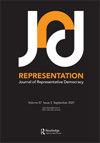排挤:美国同步选举对政治参与、候选人评价和竞选学习的影响
Q2 Social Sciences
引用次数: 0
摘要
同时举行多次选举,也被称为并行选举,众所周知,通过提高选民投票率,有利于选举制度。从本质上讲,公众变得更愿意参与投票,因为他们可以一次投票选出更多的职位,更重要的职位,从而对政府更有效地运作产生更大的影响。然而,除了投票人数的增加之外,人们对选民会发生什么知之甚少。仅仅因为公民选择投票,并不意味着他们实际上关注所有的竞选活动,或者认为他们的参与是有价值的。利用美国全国选举研究20年的调查数据,并主要关注相对不那么突出的众议院,本文考察了美国同步选举的心理影响。该研究的结论是,虽然同时进行的选举确实提高了投票率,但在同时进行的选举中,知名度较低的候选人得到的关注较少,导致公众对他们的评价更为负面,对他们的了解也更少。高知名度的公职候选人会避免这些负面后果。因此,并行选举存在一种权衡——当多个职位同时竞争时,更多的人倾向于投票,但这些选民也倾向于关注高层职位,而忽视选票的底层。本文章由计算机程序翻译,如有差异,请以英文原文为准。
Crowded Out: The Effects of Concurrent Elections on Political Engagement, Candidate Evaluation, and Campaign Learning in the United States
Holding multiple elections simultaneously, also known as concurrent elections, is well known to benefit electoral systems by increasing the rate of voter turnout. Essentially, the public becomes more willing to participate in voting because they can vote for more offices, and more prominent offices, at once and thus have a greater influence upon the functioning of government in a more efficient manner. However, very little is known about what happens with the electorate outside of the simple increase in voting. Just because citizens choose to vote, it does not mean that they actually pay attention to all the campaigns or feel that their participation is valuable. Using 20 years of American National Election Study survey data, and focusing primarily on the relatively low-salience House of Representatives, this paper examines the psychological effects of concurrent elections in the United States. It concludes that, while concurrent elections do boost turnout, lower-salience candidates receive less attention during concurrent elections, leading the public to rate them more negatively and know less about them. Higher-salience office candidates avoid these negative consequences. Thus there is a trade-off with concurrent elections – more people tend to vote when multiple offices are contested simultaneously but those voters also tend to focus on the higher offices and ignore the bottom of the ballot.
求助全文
通过发布文献求助,成功后即可免费获取论文全文。
去求助
来源期刊

Representation
Social Sciences-Sociology and Political Science
CiteScore
3.50
自引率
0.00%
发文量
31
期刊介绍:
This change in scope follows two paths. Firstly, it seeks contributors who are interested in exploring the interface between democratic practice and theory. In particular, this focus seeks contributions that apply theoretical insights to actual examples of current practice. Secondly, while not neglecting the current focus of the journal, we would like to expand its international coverage so that the journal will offer our readers insights in the state of democracy worldwide.
 求助内容:
求助内容: 应助结果提醒方式:
应助结果提醒方式:


